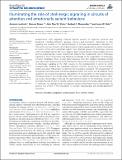Illuminating the role of cholinergic signaling in circuits of attention and emotionally salient behaviors
Author(s)
Luchicchi, Antonio; Bloem, Bernard; Viaña, John Noel M.; Mansvelder, Huibert D.; Role, Lorna W.
DownloadLuchicchi-2014-Illuminating the rol.pdf (671.2Kb)
PUBLISHER_CC
Publisher with Creative Commons License
Creative Commons Attribution
Terms of use
Metadata
Show full item recordAbstract
Acetylcholine (ACh) signaling underlies specific aspects of cognitive functions and behaviors, including attention, learning, memory and motivation. Alterations in ACh signaling are involved in the pathophysiology of multiple neuropsychiatric disorders. In the central nervous system, ACh transmission is mainly guaranteed by dense innervation of select cortical and subcortical regions from disperse groups of cholinergic neurons within the basal forebrain (BF; e.g., diagonal band, medial septal, nucleus basalis) and the pontine-mesencephalic nuclei, respectively. Despite the fundamental role of cholinergic signaling in the CNS and the long standing knowledge of the organization of cholinergic circuitry, remarkably little is known about precisely how ACh release modulates cortical and subcortical neural activity and the behaviors these circuits subserve. Growing interest in cholinergic signaling in the CNS focuses on the mechanism(s) of action by which endogenously released ACh regulates cognitive functions, acting as a neuromodulator and/or as a direct transmitter via nicotinic and muscarinic receptors. The development of optogenetic techniques has provided a valuable toolbox with which we can address these questions, as it allows the selective manipulation of the excitability of cholinergic inputs to the diverse array of cholinergic target fields within cortical and subcortical domains. Here, we review recent papers that use the light-sensitive opsins in the cholinergic system to elucidate the role of ACh in circuits related to attention and emotionally salient behaviors. In particular, we highlight recent optogenetic studies which have tried to disentangle the precise role of ACh in the modulation of cortical-, hippocampal- and striatal-dependent functions.
Date issued
2014-10Department
McGovern Institute for Brain Research at MITJournal
Frontiers in Synaptic Neuroscience
Publisher
Frontiers Research Foundation
Citation
Luchicchi, Antonio, Bernard Bloem, John Noel M. Viaña, Huibert D. Mansvelder, and Lorna W. Role. “Illuminating the Role of Cholinergic Signaling in Circuits of Attention and Emotionally Salient Behaviors.” Frontiers in Synaptic Neuroscience 6 (October 27, 2014).
Version: Final published version
ISSN
1663-3563